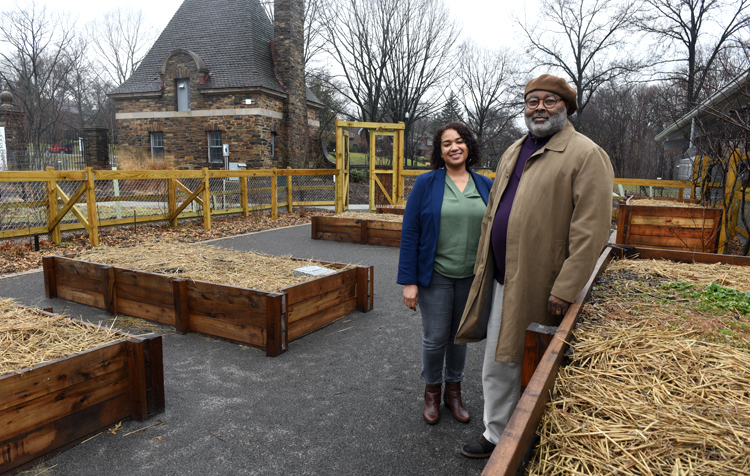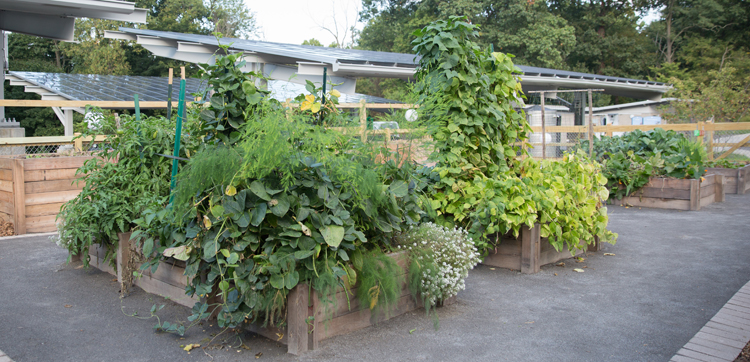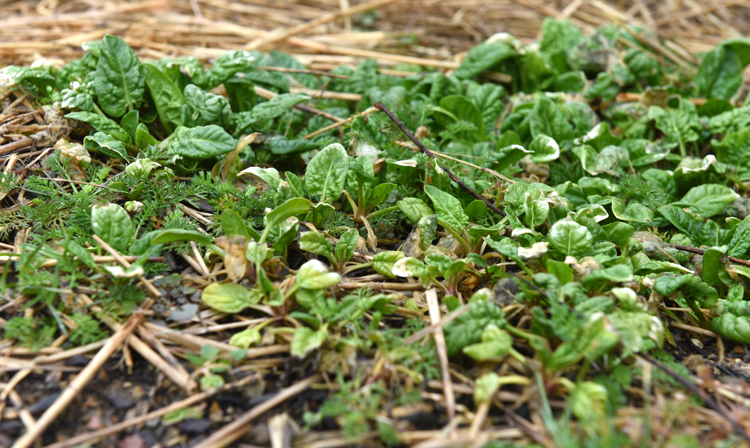From Slavery to Freedom Garden tells a powerful story
Posted on: February 22, 2018 | Written By: Doug Oster |
A heavy rain is falling outside the Frick Environmental Center in Squirrel Hill. It’s the beginning of a winter thaw, and the From Slavery to Freedom Garden near the entrance is soaking up the water preparing for spring. In one bed, small dark green spinach leaves have survived the cold, forming a carpet of green on a raised bed.

Camila Rivera-Tinsley, director of the Frick Environmental Center and director of education for the Pittsburgh Parks Conservancy, stands in the From Slavery to Freedom garden with Samuel Black, director of African American Programs at the Heinz History Center. The garden is a collaborative project between the PPC and History Center which tells a powerful story through plants.
Inside there’s a gallery of artwork featuring plants referenced in the garden on loan from the Hunt Institute for Botanical Documentation. Camila Rivera-Tinsley is director of the center and director of education for the Pittsburgh Parks Conservancy, and she’s joined by Samuel Black, director of African American Programs at the Heinz History Center. While waiting out the rain, they talk about the collaboration that began four years ago to create this garden with a message. Rivera-Tinsley inherited the project when she came to the PPC in 2016. She discusses understanding the power the environment had on slaves.
“The idea of the garden represents sovereignty,” she’s says passionately. “Sovereignty evokes this feeling of power, someone is not giving you freedom, because you are born with your freedom. You can take that freedom. The way to do that is through the knowledge of what’s growing outside.”
Provoking thought
Visitors to the garden are asked a poignant question: what would it be like to be an enslaved person and decide to leave everything and everybody you know, and how will you survive?
“The story of environmentalism, of sustainability, that we’re telling here is everybody’s story,” Rivera-Tinsley says. “Here’s a part that can draw you in, if you’ve felt you haven’t been able to be part of it.”

Decorative wooden deer fencing surrounds the garden. Raised beds that reflect what would grow in a market garden fill the center. After gaining freedom, the African Americans could use food to gain economic independence in a garden like this. They will be planted with okra, tomatoes, peppers and other garden items. At the backside of the garden are wheelchair-accessible planters where that spinach thrives. Along the edges are berries, perennials, spring ephemerals, pollinator plants and other wild plants.
“I hope that their interest will be piqued,” Rivera-Tinsley says of visitors. “They will see those plants on the edge of the garden and will want to go find them out on the trail. I want everybody to know this park belongs to them.”

Spinach survived the winter in the From Slavery to Freedom garden at Frick Environmental Center. The garden is a collaborative project between the Pittsburgh Parks Conservancy and Heinz History Center which tells a powerful story through plants.
Black directs The Slavery to Freedom project at the History Center, and this garden is an extension of what’s there. “I wanted to have a space that was an outside exhibit,” Black says.
During research for his book “The Civil War in Pennsylvania, The African American Experience,” he discovered plants that runaway slaves and those who became free used to survive and thrive. The Environmental Center had the green space and programing opportunities around the garden that makes it a perfect fit.
Looking at history
“This goes back a long time in my thinking,” he says of his interest in plants and how they relate to African Americans.
Back in 1979 when he was freshman in college learning about the Underground Railroad, a professor talked of something called “African American agency.” In most of the written history of the Underground Railroad, there’s very little mention of African Americans trying to free themselves. There’s more about white abolitionists and what they did to help people get free. That “agency” is what African Americans relied on to leave the plantation, usually into the woods where they needed to subsist on what was growing there.
“I wanted to look deeper, to answer my own question. What were the experiences of these runaways? What motivated them? How did they survive?” Black wondered.
It wasn’t the people who were chasing them that was their greatest challenge, he added, it was the natural environment.
He focused on 50 plants, some found in the wild for sustenance or for medicinal uses, and varieties people planted in their own gardens. Those included peppers, crabapples, dandelions, a native fruit called paw paw, apples, greens, cole crops, and much more.
Close to home
Speaking of dandelions, his young son picked some years ago as a present for his mother. When he came back home, the child blew the seeds over the lawn. “The next spring I’m flooded with dandelions,” he said laughing. After researching the history of the plant and how it kept people alive, Black remarked, “Now I feel guilty spraying because I understand it’s connected to my ancestors. For me, I wanted people to think differently about foods, black culture and black ingenuity.”
During the gardening season tour guides can share a taste of what’s growing, as a sort of culinary history lesson.
“Here are some of the things that people ate to survive as they were running away from slavery,” Black says. “You get an opportunity to sample some of the plants, so you’re doing the same thing in a sense that these runaway slaves were able to do.”
The garden tells a powerful historical story, and Black hopes it’s an important teaching tool for visitors.
“I want people who already have some knowledge of this history to have something totally new,” he says. “I want people who know absolutely nothing to learn something totally new. And I want to change people’s ideas about the experiences of African Americans. When they leave they’ll have a better understanding. It’s that type of impact on the public that I appreciate more than anything.”
Note: Black’s book, “The Civil War in Pennsylvania, The African American Experience” is also available at the History Center.
Doug Oster is editor of Everybody Gardens, a website operated by 535Media, LLC. Reach him at 412-965-3278 or doster@535mediallc.com. See other stories, videos, blogs, tips and more at everybodygardens.com.
More from Everybody Gardens
See also, How To Grow Roses Organically